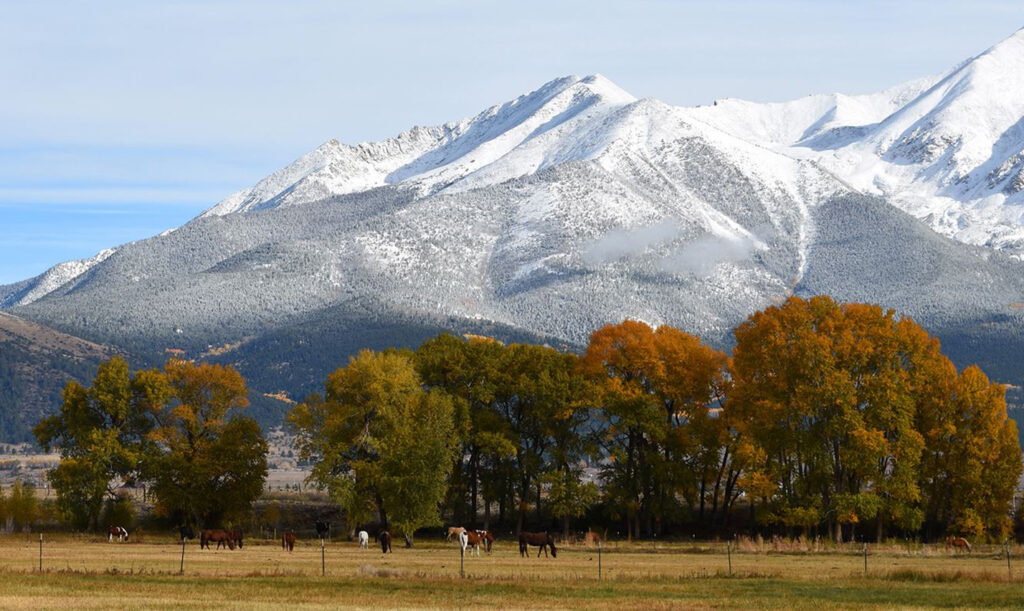7 Favorite Colorado Bouldering Areas (2024)

Looking for great places to boulder in Colorado? Here are our top 7 picks to make the best of any bouldering trip in this beautiful state.
In this article, we’ll reveal our list of the top bouldering areas in Colorado, from a resident climber who’s spent over 30 years exploring the region.
Bouldering is a form of rock climbing where climbers ascend short cliff faces or boulders without ropes or other gear aside from climbing shoes and chalk. They use only crash pads and spotters for protection, if anything.
If you’re new to bouldering and wondering what the appeal is, please check out our guide to outdoor bouldering to learn all about it!

A variety of environments and rock types make Colorado a year-round destination for pad people. From desert canyons to urban foothills to the glaciated landscapes above treeline, you’ll find classic boulder problems in nearly every sector of this mountainous state.
The sport of bouldering in Colorado also has a rich history, highlighted by climbers like John Gill (1), one of the innovators of modern bouldering methods. A university professor of mathematics from the late 1960s, he pioneered hard problems throughout the state that are still prized today.
Now, let’s get to our 7 best bouldering areas in Colorado, starting with the area closest to the state’s largest city, Denver.
1. Morrison
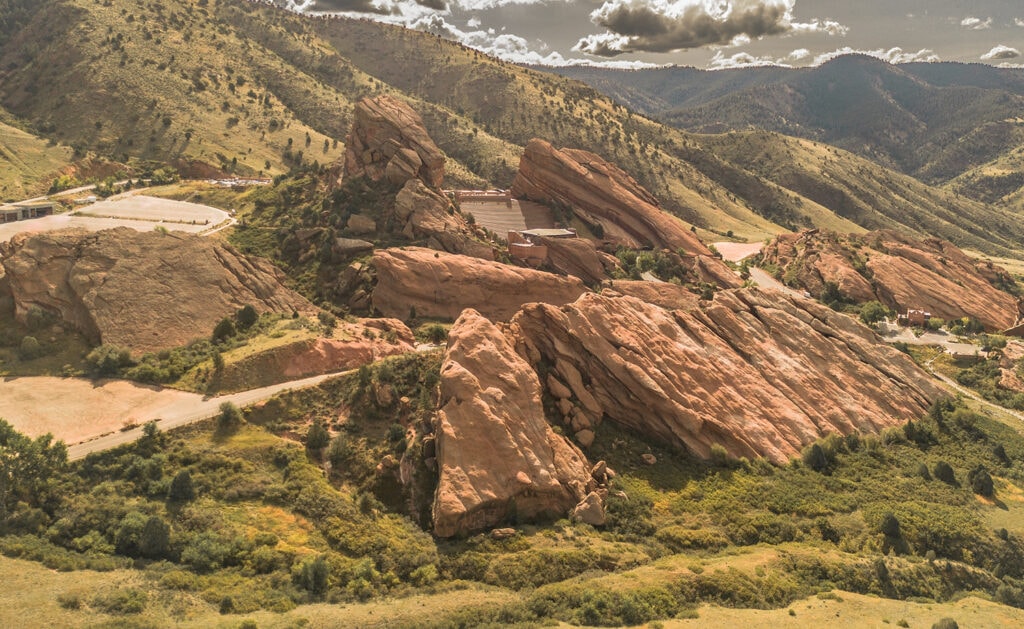
Morrison is a small town in the foothills west of Denver, located at the base of a unique “hogback” geological formation. The rock in this formation is hard Dakota sandstone, and it creates a ridge that extends across the entire state of Colorado.
The sandstone walls jutting from the Morrison hogback attracted local climbers like David Breashears (now a filmmaker and 5x Everest summiter) in the early 1970s. They established a handful of trad and top rope routes, but Morrison is historically known as a bouldering playground.
Climbing on the north side of town includes classic overhanging roof problems in the Black Hole and the Lobby. These south facing walls offer a great escape on a sunny winter’s day.
On the slope south of town, a number of tall, angular blocks are scattered across the hill in an area called The Dark Side. It’s more of an adventure to access and navigate the rocky trails, but the classic problems and bulletproof sandstone are worth the struggle.
- How to get there: From Denver, exit C-470 at Morrison / Highway 8. For free parking, use the public transit Park-n-Ride lot. For the Dark Side boulders, park on Soda Lakes Road.
- Approach: Easy, about 15-30 minutes depending on where you park and where you want to go.
- Ideal time of year: Year-round.
- Where to stay: Morrison is 15 – 45 minutes from the Denver metropolitan area.
See more information about Morrison on the Mountain Project.
2. Rocky Mountain National Park
Colorado’s alpine boulders are a testing ground for strong climbers from all across the globe, and a sanctuary from the summer heat. Rocky Mountain National Park is not only one of the most popular national parks in America, it’s known worldwide for amazing alpine bouldering at 10,000 feet in elevation.

These giant granite boulders are mostly situated in Chaos Canyon and Tyndall Gorge, with problems rated from V1 to V14 (5 to 8B+ Font). However, with a rugged approach, sketchy talus landings, and variable weather conditions, this area isn’t suited for beginners.
If you do make it here during prime season, you may run into professional climbers testing their mettle on problems like Jade (V14), first sent by Daniel Woods.
A rockslide closed Upper Chaos Canyon in 2022, impacting access to that area. Be sure and abide by official closures, along with the ban on stashing crash pads and other regulations. This alpine environment is especially fragile, so stay on the trails and minimize your impact.
For the latest conditions, check local bouldering legend and guidebook author Jamie Emerson’s RMNP Instagram feed (2).
- How to get there: Enter RMNP through the Beaver Meadows entrance for Chaos Canyon and Tyndall Gorge bouldering areas.
- Approach: Difficult, 45 minutes to an hour.
- Ideal period to go: June through October, depending on snow levels.
- Where to stay: Camp in the park or stay in one of the many accommodations in nearby Estes Park.
See more information about Rocky Mountain National Park on the Mountain Project.
3. Flagstaff Mountain

Although Boulder, Colorado is less than an hour from Denver, it seems like a distant retreat, with its pine studded hills and giant rock formations rising on the west side of the city. Appropriately for its name, Boulder is a bouldering paradise with thousands of problems in the nearby foothills.
Flagstaff Mountain is one of these easily accessible areas. With mostly moderate problems on hard sandstone boulders and outcrops, this area has a long history that dates back to the pre-bouldering pad era. This is impressive when you consider trying your hand at classic lines like Hollow’s Way (V8+), a typical 15-foot highball with thin hands and feet and a steep landing zone.
Don’t worry, though, there’s something for everyone, from short, juggy overhangs to slabby traverses with smeary edges and fingertip pockets. More than half the routes at Flagstaff come in at V4 or lower.
As with any sandstone climbing, take care not to climb when the rock hasn’t dried thoroughly after a rainstorm.
- How to get there: In Boulder, take Baseline Road west until it turns into Flagstaff Road, which switchbacks its way up the mountain.
- Approach: Easy, most problems are less than 15 minutes walk from a parking area.
- Recommended time of year: Year-round, although morning sessions might be better during the summer.
- Where to stay: Anywhere in Boulder, Colorado. The Denver metro area is 30 minutes to an hour away.
See more information about Flagstaff Mountain on the Mountain Project.
4. Mount Blue Sky
Formerly known as Mt. Evans, Mount Blue Sky is a 14,265-foot peak visible from downtown Denver. It also boasts the highest paved road in North America, which reaches the summit and conveniently provides access to rock climbers, mountaineers, and boulderers!
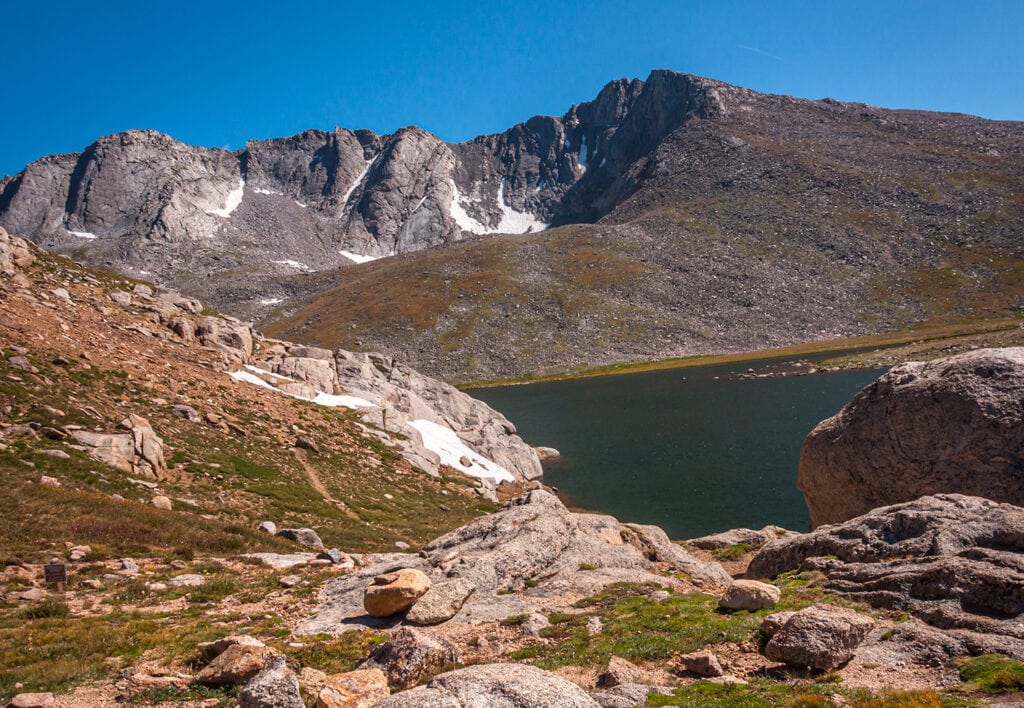
These granite alpine boulders offer another testing ground for America’s top bouldering stars, with a first ascent history that includes lines set by Jimmy Webb, Dave Graham, Daniel Woods, and Drew Ruana. Ruana recently sent Mt. Blue Sky’s hardest problem, the V16 Insomniac.
Two sub-areas hold most of the boulders at Blue Sky: Area A and Lincoln Lake. Although known for its difficult test pieces, Mt. Blue Sky has a decent selection of boulders in the V3 – V7 range for more mortal climbers.
- How to get there: From Denver take I-70 west to Idaho Springs and follow signs to Mt. Blue Sky. For Area A, park at the Echo Lake trailhead. For Lincoln Lake, take the Mt. Blue Sky Scenic Byway (reservation and fee required (6)) until you see the long, oval Lincoln Lake. Park only in official pullouts.
- Approach: Difficult to very difficult, with off trail hiking and navigation over talus, scree, and other mountainous terrain.
- When to go: June through September, depending on snow and road conditions.
- Where to stay: Stay in the Denver area or book one of the many vacation rentals in the quaint mountain towns of Idaho Springs or Georgetown.
See more information about Mount Blue Sky on the Mountain Project.
5. Independence Pass
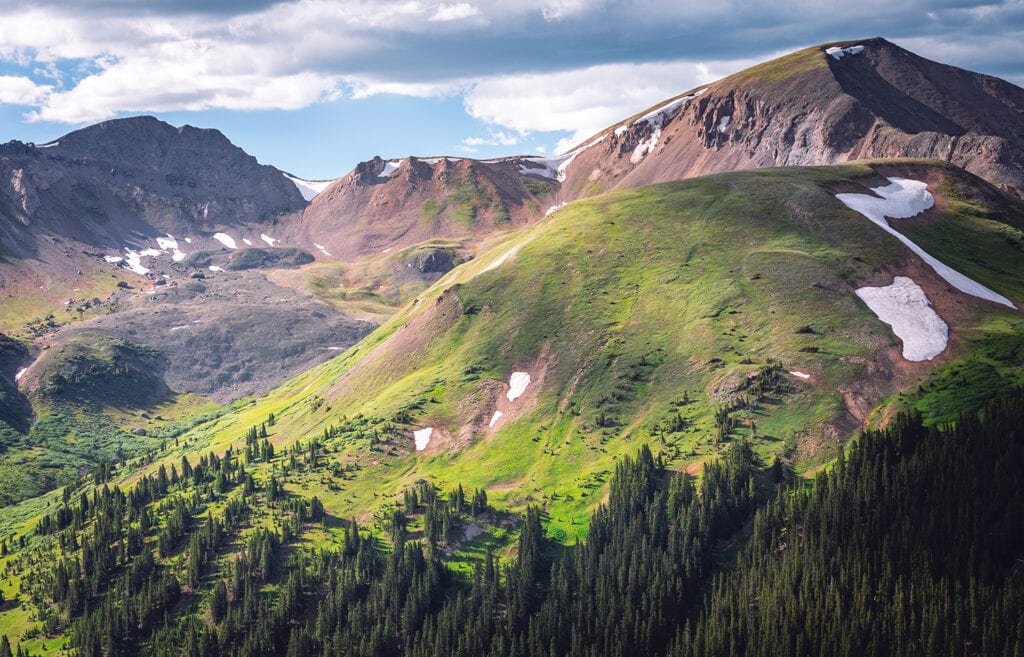
Not far from the ritzy enclave of Aspen, Colorado a treasure trove of alpine rock awaits for rock climbers of any economic status, from dirtbagger to Sprinter van elitist. With a mix of sport, trad, and boulder climbing, you’ll find days’ worth of quality stone here no matter what your discipline.
Independence Pass climbing is on US Forest Service land along both sides of Colorado Highway 82, which is closed every winter from October to May thanks to massive snowfall. The crags and boulders are composed of quartz monzonite and gneiss, with many seams, small cracks, and rounded edges.
Over 75% of the problems at Independence Pass are graded V6 or easier, so you don’t have to worry about World Cup climbers burning you off your project. This is an amazing summertime destination with climbing at 9-10,000 feet in a peaceful, forested environment.
- How to get there: Approach from Aspen on the west or from US Highway 24 on the east.
- Approach: Easy to moderate, with many climbs within sight of the road and others hidden in the trees.
- Bouldering Season: Whenever Highway 82 to Aspen is open, generally June through September.
- Where to stay: Aspen, free dispersed campsites along Lincoln Creek Rd. or paid campground.
See more information about the Independence Pass on the Mountain Project.
6. Buena Vista
Buena Vista is a small city in the Arkansas River valley, more known for whitewater rafting and as a launching point to climb the many 14,000 foot peaks in the area. Lesser known are the myriad granite and rhyolite boulders strewn across the high desert ridges and ravines east and south of the town.
The valley’s proximity to big peaks also means you’ll find granite erratics not far away in the Sawatch Range. This broad range of environments and rock types means you can find somewhere to climb on all but the coldest of days, as the elevation varies from 7,500 to 10,000 feet.
Grades are mostly moderate, with only a handful of double-digit V- problems. That’s partly due to the slabby, edgy nature of the problems. There are many highball problems over 15 feet, but plenty of lower top outs and flat landings make this a great place for beginners to explore.
- How to get there: Take US Highway 285 south from Denver for 3 hours to US Highway 24 and turn right to reach Buena Vista.
- Approach: Most boulders in the Buena Vista East area are less than 10 minutes walk from the car.
- When to go: Year around.
- Where to stay: Buena Vista or one of the nearby resort properties at Mt. Princeton and Cottonwood hot springs.
See more information about Buena Vista on the Mountain Project.
7. Unaweep Canyon
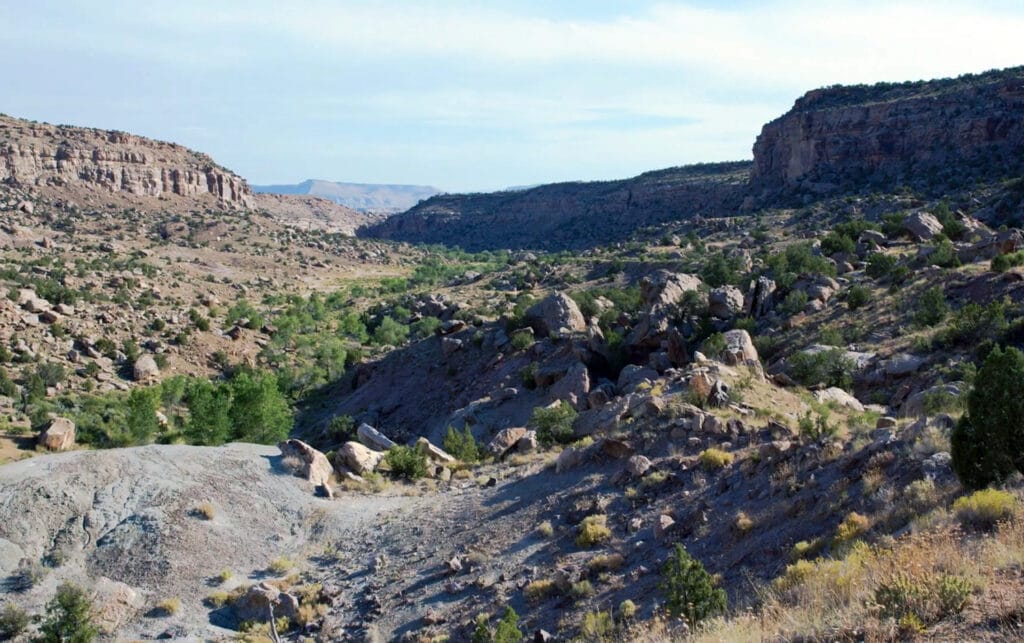
Are you seeking an adventurous climbing experience far from the madding crowds of Denver and Boulder? Unaweep Canyon is a relatively remote and little trafficked area with thousands of boulders lining the canyon slopes in the Nine Mile Hill bouldering area.
Although the main Unaweep Canyon walls are composed of granite and gneiss, the bouldering takes place on blocks of Burro sandstone, a rock that is not always solid but still offers excellent climbable features.
A paradise for the moderate climber, the vast majority of problems in Unaweep are rated V5 and below, with over 1,000 at V2 or lower difficulty. And, if you’re into exploring and making your own routes, the possibilities are endless.
Most of the climbing at Unaweep is located on US Bureau of Land Management (BLM) property, with few regulations. Enjoy the freedom and behave responsibly to protect this vital resource!
- How to get there: Drive east from Grand Junction to CO Hwy 141 and turn right. The first main bouldering area, Late Bloomer, is 1.3 miles from this intersection.
- Approach: Easy to moderate. Many climbs are less than 5 minutes walk from parking.
- When to go: October through May is best due to hot summer temps.
- Where to stay: Camp for free on BLM land or stay in Grand Junction less than 30 minutes away.
See more information about Unaweep Canyon on the Mountain Project.
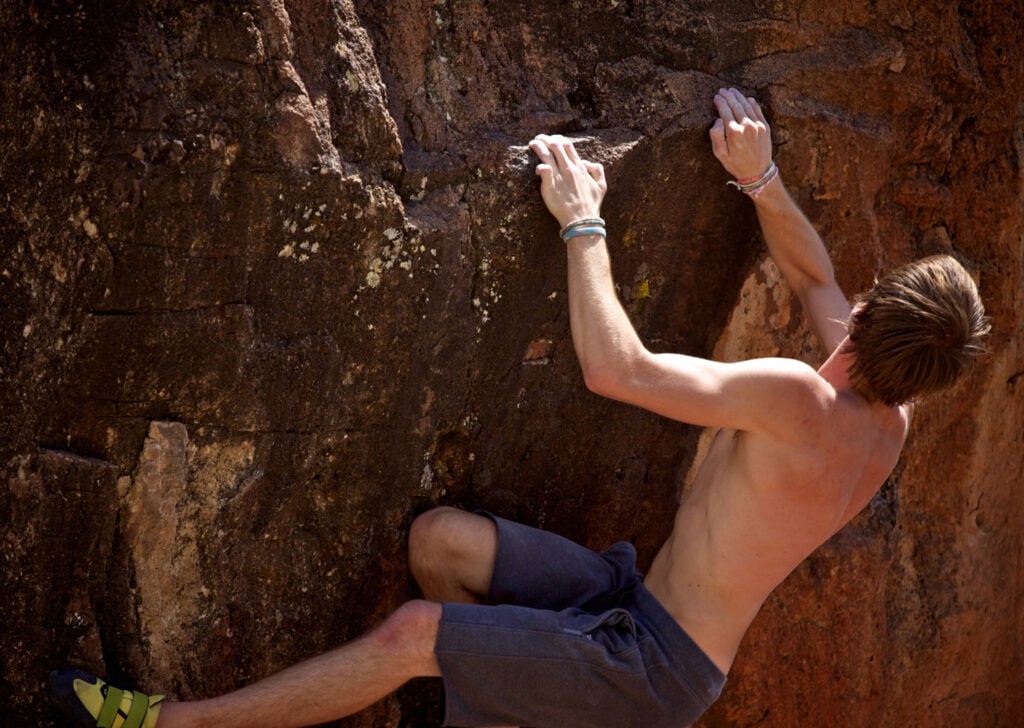
Thanks for reading, that wraps up our expert picks for the greatest bouldering areas in the incredible state of Colorado. Unfortunately, we had to leave out many other awesome Colorado bouldering spots, but this is a great list to start exploring. Good luck and climb on!
Are you looking for more climbing in Colorado, check out the overall selection of AMGA climbing guide Teddy Dondanville.
References
John Gill, Father of Bouldering
Climbing (retrieved on 10/23/2023)
https://www.climbing.com/people/john-gill-father-of-bouldering/
RMNP and Mt Evans Bouldering Guide Instagram Feed
Instagram (retrieved on 10/23/2023)
https://www.instagram.com/rmnp_bouldering_guide/

